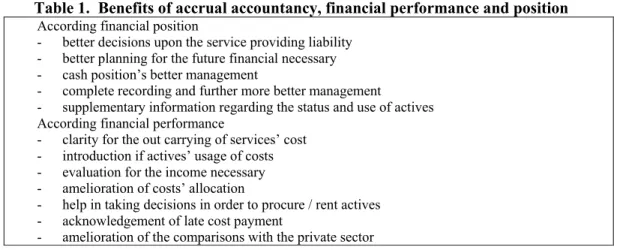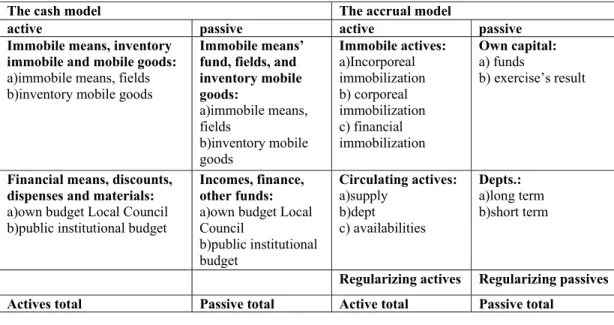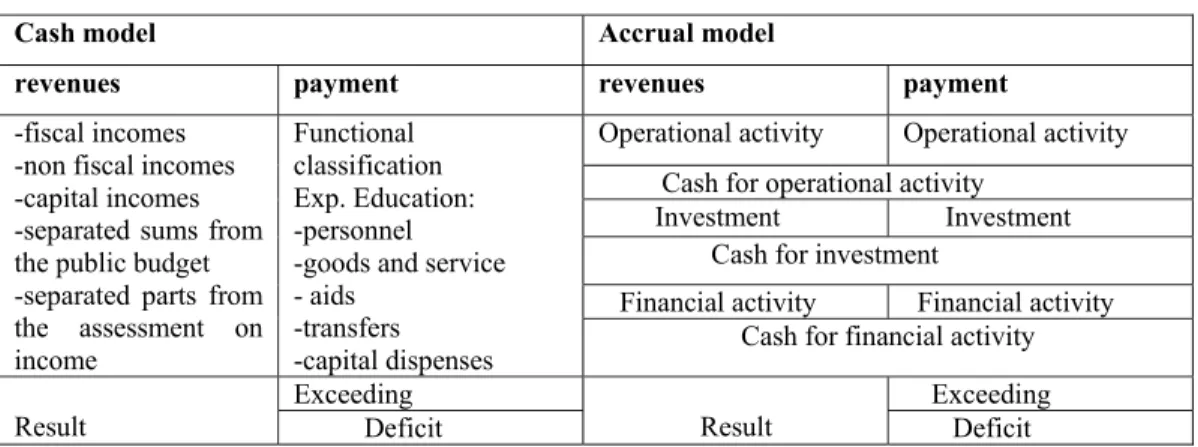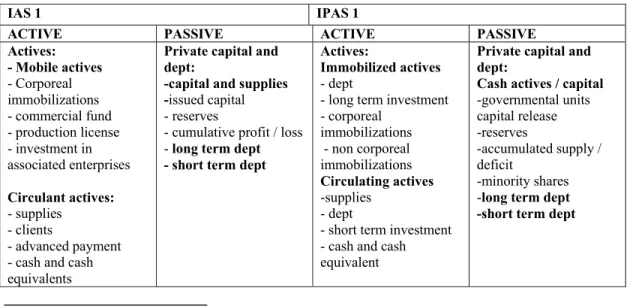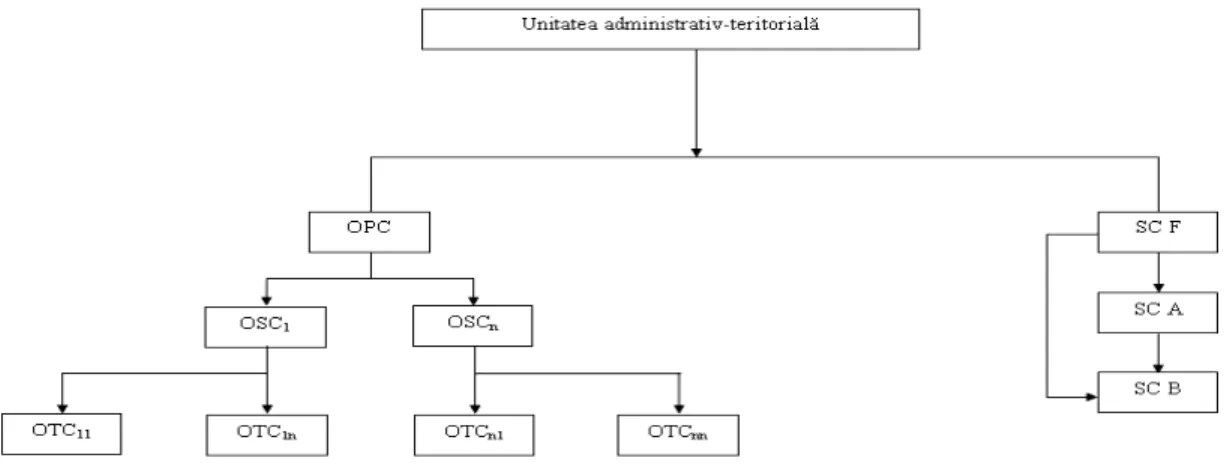193
The Anachronism of the Local Public Accountancy
Determinate by the Accrual European Model
Riana Iren RADU
raduriana@yahoo.com Dunarea de Jos University of GalatiEduard Ionescu
Spiru Haret University of BucharestAbstract. Placing the European accrual model upon cash accountancy model, presently used in Romania, at the level of the local communities, makes possible that the anachronism of the model to manifest itself on the discussion’s concentration at the nominalization about the model’s inclusion in everyday public practice. The basis of the accrual model were first defined in the law regarding the commercial societies adopted in Great Britain in 1985, when they determined that all income and taxes referring to the financial year “will be taken into consideration without any boundary to the reception or payment date.”1 The accrual model in accountancy needs the recording of the non-cash effects in transactions or financial events for their appearance periods and not in any generated cash, received or paid. The business development was the basis for “sophistication” of the recordings of the transactions and financial events, being prerequisite for recording the debtors’ or creditors’ sums.
Keywords: accountancy, creditors, transactions, public sector.
JEL Code: M41
1. Introduction
The system of double part accountancy and later the accrual system of accountancy developed in nowadays commercial accountancy practice. In Great Britain, as in the whole world, the raise of the modern business complexity reflected in the raise of the complexity in financial declarations, situations, the business model diversity leading to different variations in the style and actual volume of the financial declarations in order to satisfy the needs of different business classes. Many countries established certain accountancy practices to gain more openness since 2005, when the Standards of International Financial Reports will be adopted in more countries of the European Union. The public sector showed no passivity to the sent impulse of the modern business’ complexity and diversity. In Great Britain the accrual accountancy is now regarded as a large spread rule while in the Continental Europe the practice is still large and diverse with a clear attempt to introduce the accrual accountancy.2 The main stimuli towards the accrual movement and eventually toward a larger standardization are represented by the tasks of the national’ accountancy, by the growth of the central governments, the capital markets, and eventually by the adaptation of the International Public Accountancy Standards.
1
Bolos M.I., Local communities’ budget and accountancy between the actual state and modern possibilities, Economical Publishing, Bucharest, 2006, page 23
2
2. Targets and benefits of the accrual model in accountancy
The accrual accountancy within the targets of financial reports in business area, offers benefits that can we can sum as it follows:
Performance – measured in terms of income and consumed resources during a period of time, more profitable than paid cash.
A more complex table of the entity’s position – than a simple cash declaration
Cost calculation – which we can realize better on the basis of the consumed resources than acquisitions’.
Actives – that charge the user’s costs all through its functioning time
Investment decisions – that can be strictly fundamental on a current period of time within the past and the future context.
If for the business area there are multiple benefits of the accrual accountancy and they can answer the user’ necessities, two questions raise: to what goals does the information out of the accrual accountancy serve? And what are the benefits for the public sector? The answers were formulated separating the targets from the benefits. For the local communities in Romania and generally for all local governments in the Continental Europe the goals of reporting on accrual basis are multiple, such as:
Budget conformity – to demonstrate that budgetary resources were used according to the approved local budget,
Operational performance – to evaluate the management performance realizing economy and efficiency. The services and activities’ delivery costs become transparent and conform to local communities’ objectives.
Accountancy and administration - to demonstrate that resources were rightly administrated according to relevant rules and limited regulations in conformity with the defined goals of local governments or in order to appreciate local communities’ management, on the basis af actives and passives.
The financial condition – to offer useful information in evaluating the governments’ ability to fulfill their tasks. In Great Britain the text: “Whole Government Account” especially means the insurance that the fiscal position is strong and for a long time.
The International Federation of Accountants (IFAC) considered the benefits of the accrual accountancy structured after their financial position and performance, as it follows: table 1 benefits of accrual accountancy, financial performance and position.1
Table 1. Benefits of accrual accountancy, financial performance and position According financial position
- better decisions upon the service providing liability - better planning for the future financial necessary - cash position’s better management
- complete recording and further more better management
- supplementary information regarding the status and use of actives According financial performance
- clarity for the out carrying of services’ cost - introduction if actives’ usage of costs - evaluation for the income necessary - amelioration of costs’ allocation
- help in taking decisions in order to procure / rent actives - acknowledgement of late cost payment
- amelioration of the comparisons with the private sector
1
195
Reiterations of the accrual accountancy’s benefits were formulated by the Public Sector Committee in 2002, being similar to the benefits from business, where we can remark a consistent amelioration of the equivalent cash based information.
Essentially, to formulate the answer to the second question, the benefits of the accrual accountancy may be reduced to:
completion
better planning, better management, better decision taking ability ability to change behavior
performance’ s management financial elasticity valuation
3. Methodological – theoretical instruments for the accrual model
The model is asked by the accountancy international standard ESA 95, compatible in a systematic and detailed description of the economy and its large, as well as its components and relations within other economies. At the same time, the model is necessary to governmental reports, International Monetary Fund’s information being in conformity with the tasks of the accrual model.
The accrual accountancy is more complex than cash accountancy because: it offers the possibility of a better management of the decisional process it confers exhaustive information regarding the actives and the passives it offers a better evaluation of the financial situations
it helps to identify the efficient model of resources’ usage.
The accrual accountancy involves a number of risks, such as: procedures and accountant regulations’ revising
the personnel consistent formation
long time implementation the model’s finality is based on the making up and the presentation of the financial situations1, proceeding after all the informative procession, following the tasks of the accounts’ plan, attributing values with evaluation help, and then the given elements are to be taken in defined structures showing position or financial performance in order to evaluate the financial sanity of the public sector.
Instruments for the accrual accountancy are: accountant policies
accountant treatments accountant principles
The accountant policies2, defined as specific principles, conventions, rules and practices adopted by a public institution charged with the preparing and presenting the financial situations that has to accomplish two quality tasks:
a) relevance for the user’s needs in decision taking;
b) credibility for their sharp results and the financial position (neutral, prudent, complex in each important aspect).
1
Bolos M.I., Local communities’ budget and accountancy between the actual state and modern possibilities, Economical Publishing, Bucharest, 2006, page 47
2
Alterations in accountancy policies are allowed only if asked by the law or if they result in more credible and relevant information for public institutions. According to the mentioned regulative frame, they aren’t called alterations:
a) the adoption of a accountant policy for events and transactions that differ from the stated, past transactions;
b) the adoption of a accountant policy for past insignificant events and transactions.
Practice has elaborated different accountant policies that regard balance items: rules to admit and evaluate the balance items in public institutions;
rules to establish the depreciation and reversibility of the depreciation loss;
comparisons between rules from IPSAS and those from IAS and the correction of the accountant policies with differences resulting out of comparisons.
The alterations of the accountant policies must be gathered in explaining notes so the users can appreciate both the property of the new chosen policy and the its effect upon the results.
4. A new product for the local communities in Romania: accrual based financial situations
We’ve analyzed before the benefits and the portfolio of the methodological theoretical instruments that fundamental the accrual model resulting in accrual information more complex than cash information, because all transactions and events are acknowledged at the date of their process and not at the date of their payment.
The final result of this analysis wouldn’t take place unless the architecture of these accrual financial situations were perfectly researched, so that the reader can get used to a number of model defining items, such as:
financial actives and modern discount instruments, financial products for resources supply,
Introduction of the concept as a result of the exercise, etc.
For the main groups of balance’s items, we have the following situation:
a) At the level of the immobile actives – considered as main active elements where public funds are retained for a long terms, actives are grouped within their nature: incorporeal retains, corporal retains and financial retains.
- We won’t stop upon their economical content, but it would be interesting just to enumerate the items they content due to the accrual model information. - Actives are grouped in the accrual financial situations, according to their
liquidity degree (their ability to be transformed in cash): in mobile and immobile actives.
- In the accrual financial situations two new immobile active groups have been introduced: incorporeal and financial immobility, mainly determined by the public institutional diversification.
- Balance’s posts: relaxing, literary, original art works, activated actives, deposits, uncultivated biological resources, water resources, participation titles, more than a year immobile liabilities, new introduce positions that will ensure long term public funds, depending on the public institution activity’ specific. b) At the level of the moving actives – grouped in the accrual model after their ability to
197
c) At the level of own capital – the proper funds are reflected as sources of public actives construction being destined to finance long term structures in balance actives that represents radical reformation of the actual third class “ cash accountancy funds”. Essentially, the result of the exercise reflected into the accrual model describes the difference between the valued rights in the budget’s favor and the obligations remitted at the moment of their creation, while the reevaluation reserves represent the difference between the market value of the public actives and their marketing price.
d) At the debt’s level – known in the specialized literature as advanced forms of capital (public funds) to ensure the current activity development and investments, the debts are grouped according to the accrual model in two categories: over one year debt and less than one year debt, that illustrates the type of categorical grouping and the items that compose them.
e) At the level of the advanced registration – as in the situation of the dispenses in advance or any other regular dispenses, the regulative passives correct both the balance elements’ value, reflecting those sums resulting from over planned current level incomes, and the charged money with unknown destination and they are registered with “clarifying settlement operations”.
Profound mutations take place at the level of informational structure within the exercise. We showed in the present paragraph that this type of result is determined, mathematically at least, at the level of the difference between the total of registered income at the date of and the rightful income pay in budget’s favor and total dispenses at the date of the tax liability pay date.
The result of the exercise brings up other result categories as intermediate capital accumulations such as: operational result, financial result, extraordinary result. The presentation of each category will essentially explain the method of the result and its components.1 We have:
• For the operational result – determined as a difference between operational incomes and operational dispenses, are included:
a) in the category of operational incomes:
- economical activity’ s finances and incomes
- subvention incomes or budget allocations with specific destinations - incomes from immobilization production and other activities - special funds and budget incomes
- budget incomes
- capital allowance of operational activity b) in the category of operational dispenses:
- stocks dispenses
- works and services provided by tertian - other services dispenses from tertian works - Personnel dispenses
- Other operational dispenses
- Other dispenses financed from the budget - Capital dispenses and budget dispenses
- Operational dispenses regarding the writing off of the capital and capital allowances
- For the financial result – determined as a difference between the financial incomes and dispenses, its structure being like it follows:
1
a) for the financial incomes we take into consideration: - incomes from selling financial actives
- incomes from financial immobilization - incomes from immobilized debt
- incomes from the difference of the change rate - incomes from bank rates
- other financial incomes
b) for the financial dispenses we take into consideration: - loss from the participations’ dept
- dispenses from financial disposed investment - dispenses from the change rate differences - dispenses regarding the bank rates
- other financial dispenses
- financial dispenses regarding capital allowances capital depreciation.
For the extraordinary result – created from those elements of incomes and dispenses that have nothing to do with the current activity or the investment of the public institutions, determined as their difference, including:
a) for extraordinary incomes: incomes from extraordinary appreciations b) for extraordinary dispenses: loss dispenses and extraordinary depreciations.
The forms taken by the exercise’s result will lead to some indicators determination, such as the ordinary result created by the sum of the operational result and the financial one, that will stand as basis for the determination of the intermediate accounting balance as potential accumulation balance of public capital.
5. The passing from accrual to cash in Romania. Compared analysis of the two models.
The process of modernization of public accounting, determined by the passing from cash accounting to engagements’ accounting, is remarked by its four principal elements of reformation determined by:
1) Registration of the reevaluation of the immobilized actives
2) Registration of the capital depreciation and the definition in context of depreciating actives.
3) The constitution and registration of capital allowances for the reversible depreciation of active’s elements.
4) Registration, at the time of remarking the rights, of fiscal dept due to the budget tax payers, and at the time of obligations’ constitution towards the goods and services suppliers.
The goal of the four reforming elements introduction follows the approaching between the accountancy and the real image reflection of the transactions and events, following:
To reevaluate – correcting the registered value of the public actives within the market value established price by specific methods.
For amortization – the registration of physical and moral wear of the fixed public actives to reflect their real value.
For the capital allowances – active reversible depreciation’s risk cover.
For dept and claims – dept registration at the payment due’s creating moment and the dept at the of rights’ registration moment into the budget.
199
Table 2. Differences between the accounting cash and accrual models
Cash model - characteristics Accrual model - characteristics
• It registers public actives at historical cost
• It doesn’t use reevaluation as specific process of the accountancy to correct the market value by the historical public active value registration
• It doesn’t register the physical and moral wear of the public actives
• It registers the incomes at the registration moment and the dispenses at the moment of the charge.
• It doesn’t use the capital allowances for the cover of the risks coming from the institutional activity.
• It registers the public actives at the market value, using reevaluation as specific accountancy process
• It registers the physic and moral wear of the public actives using the amortization as specific process
• It registers the capital allowances as risk cover modality
• It registers the dept and the claims in accrual basis
The characteristics that make the difference between the two models are the result of the accounting treatment for transactions and events:
For cash based model, the transactions and the events are recognized at the payment moment
For the accrual based model, the transactions and the events are recognized at their factual moment.
The differences are also determined by the financial situation structures, as it follows: The cash model presents the accounting balance, as we already said mixed with the results’
account, while the budgetary execution account is made after the functional classification and then detailed after the economical classification.
The accrual model presents the performance and financial position situation independently, apart from the cash flux situation, ordering the balance elements after their degree of liquidity, while in the results’ account the incomes and the dispenses are registered after their nature.
Synthetically, the differences regarding the accounting balance’s structure for the two models is:
Table 3. Differences of the balance’s structure in cash and accrual models
The cash model The accrual model
active passive active passive
Immobile means, inventory immobile and mobile goods:
a)immobile means, fields b)inventory mobile goods
Immobile means’ fund, fields, and inventory mobile goods: a)immobile means, fields b)inventory mobile goods Immobile actives: a)Incorporeal immobilization b) corporeal immobilization c) financial immobilization Own capital: a) funds
b) exercise’s result
Financial means, discounts, dispenses and materials:
a)own budget Local Council b)public institutional budget
Incomes, finance, other funds:
a)own budget Local Council b)public institutional budget Circulating actives: a)supply b)dept c) availabilities Depts.: a)long term b)short term
Regularizing actives Regularizing passives
Differences are obvious from the point of view of the budgetary execution account structure according to the two models:
Table 4. Cash differences in cash and accrual models
Cash model Accrual model
revenues payment revenues payment
Operational activity Operational activity
Cash for operational activity Investment Investment Cash for investment
Financial activity Financial activity -fiscal incomes
-non fiscal incomes -capital incomes -separated sums from the public budget -separated parts from the assessment on income
Functional classification Exp. Education: -personnel -goods and service - aids
-transfers
-capital dispenses Cash for financial activity
Exceeding Exceeding
Result Deficit Result Deficit
The four mentioned reforming elements have been regulated by the Romanian accounting regulators within various adopted rules, so the accrual model implementation status is presented in the following table:
Table 5. Adopting the rules for accrual implementation model
Reforming element
Adopted rule
Reevaluation
G.O. no. 81 / 2003 regarding the reevaluation and the amortization of the fixed actives in the public institutions’ patrimony.
OMFP no. 1487 / 2003 regarding the public norms approval within the reevaluation and the amortization of the fixed means in the public institutions’ patrimony.
Amortization G.O. no. 81 / 2003 regarding the reevaluation and the amortization of the fixed actives in the public institutions’ patrimony.
OMFP no. 1487 / 2003 regarding the public norms approval within the reevaluation and the amortization of the fixed means in the public institutions’ patrimony.
Capital allowances
No present regulations
Accrual recording of dept and claims
OMFP no. 520 / 2003 to approve the methodological norms regarding the accountant budgetary income organizing and conducting
From the analysis of the accrual model status we can see that up to present the capital allowances and the dept are with no regulation frame in accrual basis.
201
registration of the main operations that make the fable basis of the new accountancy accrual model.
IAS 1 – IPSAS 1 Comparison. Main differences detection
More active participation on the capital market as lenders and major Romanian local community investment realization bases a transparent and trustful accountancy, necessary for the local authorities to fundament the decisions but also for the creditors interested in financial resources placements disposable on minimum risk conditions and minimal profitability.1
The International Accountancy Standards ensure the elaboration and the making of financial situations, in order to represent the financial position, performance and cash flux of the public entities including local communities. The public financial situations, according to IPAS and IAS contain:
a) the real financial estate b) the financial performance c) the cash actives modification d) the cash flux situation
e) Accountant policies and comments upon financial situations.
The standards offer guiding for the presentation of the financial information, in order to get a correct presentation of the governmental financial condition and the local communities resulting out of transactions and events. Determining the right information asks for the professional judgment exercise.
A correct presentation supposes to respect a number of tasks contained in IPAS 1 such as: Selecting and applying the accounting policies according to IPAS
Informing in a relevant way, comparability and the truth of the information
Revealing extra information when IPSAS tasks are not enough to offer the users the impact understanding of certain events and operations on the financial performance and status of public entities.
The leaders of the public entities – credit orders (main, secondary or tertian) – may develop private accountant policies, but they will take into consideration the following tasks:
IPAS directions, referring to similar aspects
Definitions, recognition of the active evaluating criteria, dept, incomes and dispenses described by the Public sector Committee
Other standards prospects that establish the public or private sector organizations and practices up to a certain level and that apply this standard (exp. IASC (IASB) prospects include the general frame to elaborate and present the financial presentation.)
The International Public Accountancy Standard - IPAS 1 will bring fresh air to Romanian local communities for the elaboration and presentation of the financial situations, as a final product of local public accountancy. Leaving behind the old cash model’s concepts where the principle of r connecting the means to the funds ruled, the local communities meet now new concepts such as:
Financial performance, financial position, cash flux situations, accountant policies, explaining notes towards the financial situations. The target followed by IAS 1 is to ensure a financial
1
structured representation of the enterprise and to offer information upon the financial position, performance and cash flux of that enterprise, useful to a large area of users to fundament the economical decisions.1 IPAS 1 establish the same objective for the public financial situations, to supply information regarding the financial performance and position of a given public entity plus offers the information referring to resources and their use according to the approved budget. The same objective is established by standards for the local communities, including the public attendant institution. In comparison, in table 6, we present the number of items of the financial situations (according to IAS 1 IPAS 1)
Table 6. Comparison between the items of IAS 1 and IPAS 1
IAS 1 IPAS 1
• Balance
• Profit and loss account
• A situation reflecting either:
• All the private capital’s modifications
• Private capital’s modification, others but those coming from capital transactions with owners and directed to owners
• Cash flux situation
• Accountant policies and explaining notes
• Balance
• Profit and loss account
• Modification situation of net actives / capital
• Cash flux situation
• Accountant policies and explaining notes
From the compared analysis we see that the posts in balance are established according to the activity’s specific ( for enterprises and public sector), the content of the posts in the passive balance being determined by fact that in public institutions the capital is not divided in shares, and its provenience’s source is coming from budgetary sources. The ordering principles of actives and passives are the same – public or private sector – according to the liquidity period, being framed as current or non-current actives, namely current or non-current passives.
Table 7. Balance comparison: IAS 1 – IPAS 1
IAS 1 IPAS 1
ACTIVE PASSIVE ACTIVE PASSIVE Actives:
- Mobile actives
- Corporeal immobilizations - commercial fund - production license - investment in associated enterprises
Circulant actives:
- supplies - clients
- advanced payment - cash and cash equivalents
Private capital and dept:
-capital and supplies -issued capital - reserves
- cumulative profit / loss
- long term dept
- short term dept
Actives:
Immobilized actives
- dept
- long term investment - corporeal
immobilizations - non corporeal immobilizations
Circulating actives
-supplies - dept
- short term investment - cash and cash equivalent
Private capital and dept:
Cash actives / capital
-governmental units capital release -reserves
-accumulated supply / deficit
-minority shares
-long term dept
-short term dept
1
203
The exercise’s result is different in name, in the public sector the result is known as exceeding or deficit, the same result for the private sector is called profit or loss. In the results’ account1, the definition for the term “extraordinary elements” differs from the one used in IAS 8 – “ the net profit or the loss of the period, fundamental errors and modifications for the accountant policies”, meaning that the extraordinary elements are beyond the entity’s control or influence. Other differences between IPAS 1 and IAS 1 come from a different terminology, the most important examples being presented in table 8.
Table 8. Correlations in used notions for IAS 1 – IPAS 1
IAS 1 IPAS 1
Enterprise Income Balance
Profit or loss account capital
Unit Income
Financial situation’s position Financial situation’s performance Net actives / capital
There are previsions in the transitory disposals that allow not mentioning the excluded elements from the financial situations for the reason of applying some transitory disposals, according to a different standard. The IPAS 1 standard contains a quality characteristics’ synthesis (based on IASC structure).
The mentioned comparisons are also available for Romanian and Continental European local communities, the structure of the financial performance and position structures being the same as mentioned in this paragraph. The elaboration’s methodology for public financial situations is presented in the following illustration:
Figure 1. Elaboration Methodology for consolidated financial situations
Explanation:
OPC – chief accountant; SCF – F commercial company OSC – secondary accountant; OTC – tertian accountant
SCA – A commercial company; SCB – B commercial company
1
The methodological elaboration analysis for consolidated financial situations serving the local communities reflects:
For the left part
1. Territorial – administrative unit1 is considered the leader of the group (sometimes this notion may be interpreted as incorrect for the public sector), the unit approves and authorizes payment flux for the subordinated institutions.
2. the subordinated units, usually being juridical personality, whose leaders are chief accountants and they finance their own current dispenses and capital with budgetary resources.
The financial situation consolidation is made for the left part by aggregation. Nowadays we apply the modified cash model, the consolidation being a simple mathematical adding of the balance active or passive elements from the financial situations drew up by subordinated institutuions.
For the right part
The right part refers to those situations where the territorial administrative units (districts, cities, villages) have as share holders, parts of the social capital of the commercial companies (usually in public service) or they participate with different goods and services as associations in participating. The right part confers innovating character to the consolidated financial situations because the local communities, according to the Standards, will have to register parts of the social capital, reserves and the result of the exercise belonging to subordinated units.
The regulating frame offered by standards referring to consolidated financial situations contains (for the public sector):
IPAS 6 – The consolidated financial situations and the subordinated units’ accountancy – regulate the accountant practices from the superior unit ( for the case of local communities in Romania – the territorial administrative units) and the subordinated units ( chief accountant and societies where the territorial administrative units take shares or contributed in goods and services for association in participating).
IPAS 7 – Investment accountancy in associations – refer to the situation where the superior unit influences the subordinated units, called associated units.
IPAS 8 – Financial interest reporting for associations in participating – refer to the situation where two or more superior units control on the basis of a written agreement about the association in participating.
References
1. Bojian Octavian, General accountancy, Efficient publishing, 1998
2. Botea M., Dascalu C., Budgetary Accountancy, Lucman Publishing, Bucharest, 2003
3. Pantea I.P., Bodea Ghe., Financial Accounting actualized to European Standards, Intelcredo publishing, Cluj Napoca, 2005
4. Ghitu G, Tudorache S, Pitulice C, Public Institution Accounting, CECCAR House Publishing Bucharest, 2003
5. Bolos M.I., Local communities’ budget and accountancy between the actual state and modern possibilities, Economical Publishing, Bucharest, 2006
6. Cemusca L. Accountant Strategies and policies, Economical Publishing, Bucharest
1
